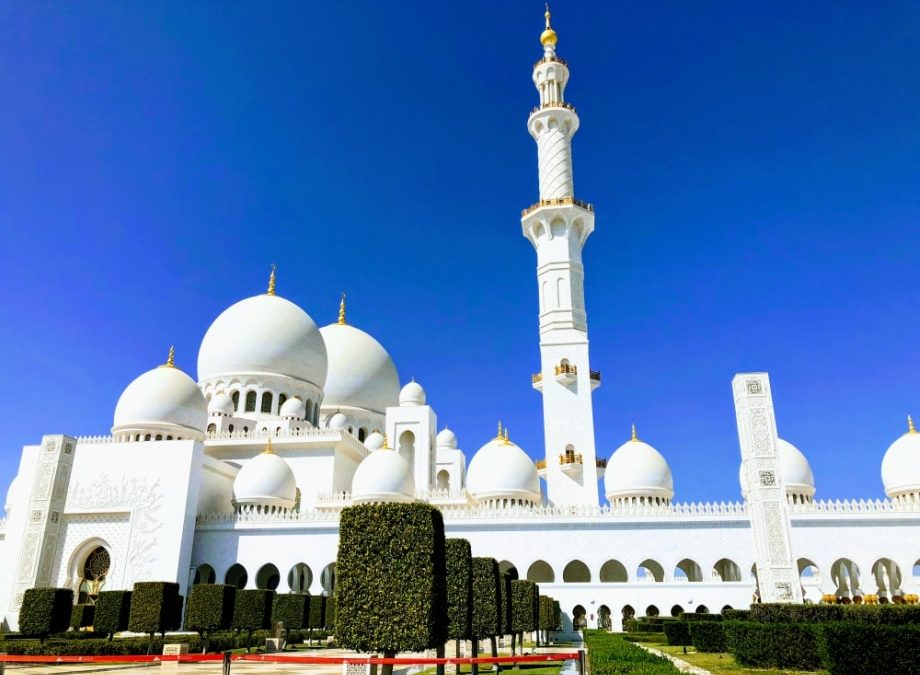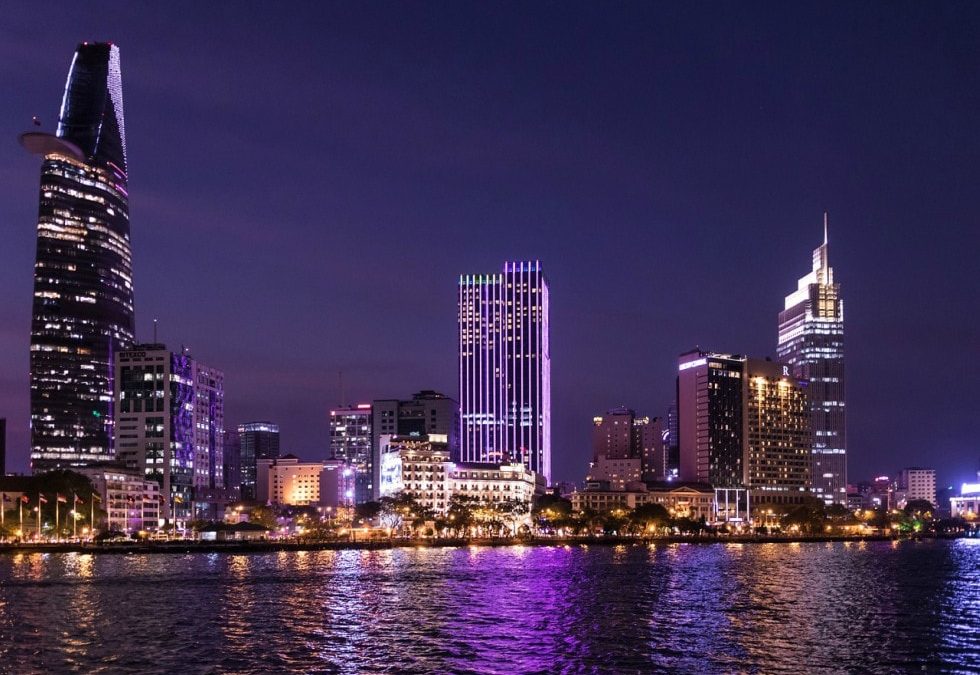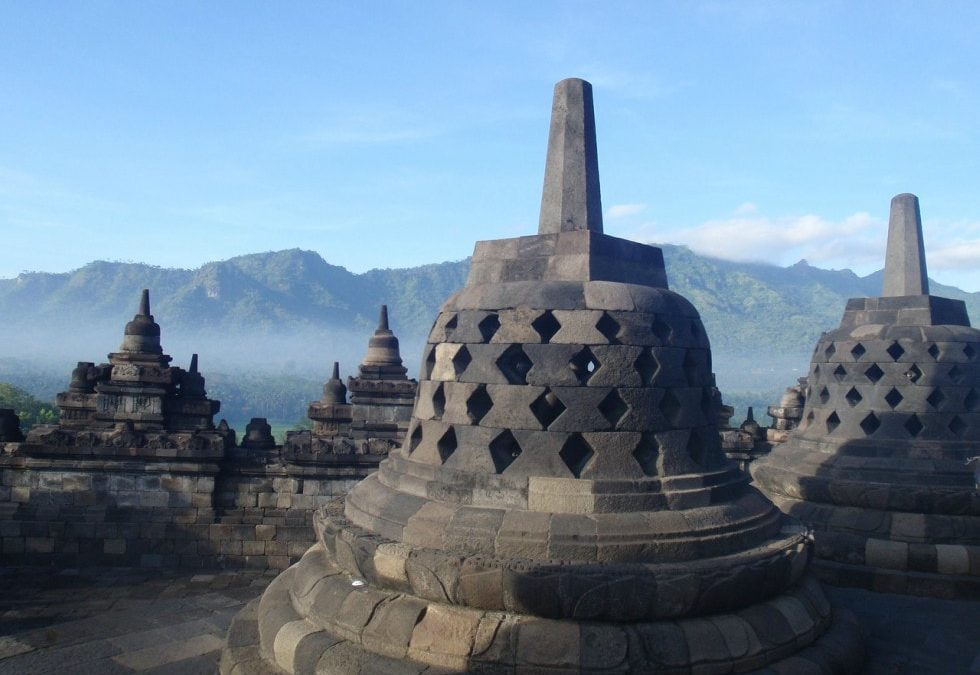
Things to Do and Eat in Abu Dhabi and Dubai, UAE: 5-day itinerary
Sunny Abu Dhabi and Dubai are the ideal places to escape from the cold winter. Learn here what you can do and eat during a 5-day trip in both cities!
DISCLAIMER: This page contains affiliate links, which means I will get a small commission, at no extra cost to you, if you make a purchase through it. If you decide to use my links, I would like to sincerely thank you for your support to my blog!
The winter temperature has hit a record low in Europe and US lately. So what can be better than escaping it and basking in the sun in Abu Dhabi and Dubai instead?
Both cities need no more introductions. Dubai has been one of the ten most popular tourist destinations in the world, offering a combination of modern skyscrapers, luxurious resorts, shopping malls, and other opulent luxuries.
Abu Dhabi, the capital of the country, is a little smaller than Dubai, but definitely not less ambitious. It has recently been investing heavily to attract more tourism.
Both cities also have amazing and diverse food scene, brought in by immigrants coming from many different countries in Arab, Middle East, and Indian sub-continent.
In this post, I would like to share with you a 5-day itinerary from my trip to Dubai and Abu Dhabi, full of tips for things to do and eat. Hopefully, this serves as an inspiration for your own future itinerary.
As always, I will also provide some HONEST tips and information to help you prepare for your trip, even before you arrive in UAE. So here you go!
Things to Do and Eat in Abu Dhabi and Dubai, UAE: 5-day itinerary
Pre-arrival
To help you prepare your visit before you arrive in UAE, here are few essential tips to keep in mind.
#1 – Combine your visit To both Dubai and Abu Dhabi
I absolutely recommend combining your visit to both Dubai and Abu Dhabi, especially if you plan to stay for about a week or so in UAE. And it is extremely easy and affordable to travel between both cities.
Both Dubai and Abu Dhabi are hubs of two major Middle East carriers, Emirates and Etihad respectively. Both carriers often have fantastic promotion offers (although Emirates has it more often than Etihad, in my observation). Therefore, I would recommend tracking the prices of both carriers and fly with the one with the best offer.
There is an express bus line connecting Dubai and Abu Dhabi. It departs every 30-40 minutes, and the 2-hour journey costs 25 AED (~$6) one-way. When departing Dubai, you can simply use the NOL card to pay (I explain later more about this card). But to return from Abu Dhabi, you have to buy a ticket at the ticket office at Abu Dhabi main bus terminal.
You can take the bus from several bus terminals in Dubai. The first one is Al Ghubaiba bus terminal near Dubai Creek, and the second one is Ibn Battuta terminal near Jebel Ali. Both terminals can be reached easily by metro.
The bus is very comfortable and clean, with wide seats and air conditioning. The bus stops in Abu Dhabi at the main bus terminal near Al Wahda Mall.
#2 – Hotels or Airbnb?
Due to their heavy focus on tourism, it is no wonder that both cities have endless options for accommodation. There are literally tons of excellent hotels in Dubai and Abu Dhabi. Hotel prices are generally similar to the price level of big cities in Europe. I myself stayed at this elegant JW Marriott Hotel in Deira, Dubai.
If you choose Airbnb instead, the quality of Airbnb accommodation in both cities is just phenomenal, and with a very reasonable price, which can be cheaper than hotels.
Don’t forget to use this link to get €30 off for your first booking.
#3 – Currency and payment
In terms of money, I would recommend using your credit card whenever possible. All major credit cards (Mastercard, Visa, and Amex) are widely accepted in Dubai and Abu Dhabi (even in souk and public transport).
In case you’d like to exchange some money before your departure, UAE’s currency is called Emirati Dirham (AED). As of today, the exchange rate of USD to AED is around 3.7 AED (1 USD = ~3.7 AED).
As always, instead of exchanging money at home, I would suggest doing so in UAE upon your arrival, as you will tend to get a better rate.
ATM cash withdrawal would cost you around 1% of the withdrawn amount, according to my experience.
#4 – Visa and permit
In case you need a visa to enter UAE, the easiest way to obtain it is to fly with Emirates or Etihad. These airlines can help sponsor and arrange your tourist visa (for 30-day stay) against a fee of 350 AED (~$90).
After booking your airplane ticket from Emirates or Etihad, you can submit your visa application online. In my case, the visa was done within an hour after applying.
Some hotels and travel agencies can also help you to arrange one, but you are either required to stay at those hotels the entire time or take a tour package from those travel agencies. In any case, don’t forget to research carefully and compare the price they offer for this service.
Upon arrival
If you fly to Dubai, you will arrive at Dubai International Airport. To get you from the airport, you can take either taxi or metro. The most economical and recommended option is to take a metro (cost around 5-8 AED, depending on the zones), unless you have a lot of luggage or your destination is difficult to reach by metro.
For that, you will need an NOL card, which you can buy (and top up) at ticket offices at the metro stations in Terminal 1 and Terminal 3. I recommend buying the NOL Silver card (cost 20 AED, incl. 14 AED worth of balance) that can be used for multiple zones. Note: the NOL card can only be used in Dubai.
If you fly to Abu Dhabi, you will arrive at Abu Dhabi International Airport. Unfortunately, the only viable option to get from the airport is to take a taxi. A cab ride to the city will cost around 80 – 100 AED (~$20 – 25). Another less favorable option is to take a bus, but it has an infrequent schedule and it will unlikely get you directly in front of your door.
Uber does not exist in UAE. But in Dubai, there is a local ride-hailing app called Careem. I did not try using it because the price is basically the same as the local taxi.
Get My Quick FREE Travel Checklist!
Subscribe now to get my quick FREE Travel Checklist.
I will also send you latest updates on travel tips, food and other travel stories from around the world!
Itinerary and Food
Day 1 – Abu Dhabi
Things to do:
#1 – Corniche Road

The Corniche Road is an 8 km long road, stretching along the shoreline of Abu Dhabi.
It has a spectacular waterfront, lined with separate pedestrian and cycle pathways, cafés, children’s playground and serene parks. You can go for a morning jog, biking, having a relaxing stroll, or basking in the sun at the Corniche Beach.
Location: Corniche Road, Abu Dhabi
#2 – Emirates Palace

Emirates Palace is the most luxurious and opulent hotel in Abu Dhabi, rivaling its Dubai’s 7-starred counterpart, Burj al Arab.
Located at the southern tip of the Corniche, the hotel has a unique Arabic architecture, quite similar to a sultanate palace. You can visit the hotel freely, admiring the luxurious interior, while sipping a cup of coffee or tea in its restaurant. You can even buy gold from this gold vending machine in the hotel.
Location: Emirates Palace, West Corniche Road, Abu Dhabi
#3 – Marina Mall
Located adjacent to the Emirates Palace, enjoy some shopping spree in this most stylish mall in Abu Dhabi.
In addition to retail stores, Marina Mall also includes a bowling alley, cinema, and an observatory deck.
Location: Marina Mall, Marina Village, Abu Dhabi
Food:
#4 – Shawarma
Shawarma is a quintessential Middle Eastern dish, consisting of a stack of meat (usually chicken or lamb) marinated with a mix of Middle Eastern spices.
Typically served with flat pita bread, the juicy and slightly charred sliced meat will certainly make your mouth watering.
Shawarma is very affordable and can be easily found everywhere, but you can sample one at Shawarma Street in Abu Dhabi.
Location: Shawarma Street, 9th Street, opposite Etisalat, near National Hospital, Najda, Abu Dhabi
#5 – Zaatar
Dubbed as “Arabic pizza”, zaatar is a type of flatbread topped with a Middle-Eastern herb mix (which is called “zaatar”), consisting of dried hyssop leaves, sesame seeds, salt and other spices.

Image courtesy of Maureen Abood
The flatbread is so fragrant, crunchy and delightful. And a little extra topping of cheese will make it even more irresistible!
You can also sample zaatar at Shawarma Street in Abu Dhabi.
Location: Shawarma Street, 9th Street, opposite Etisalat, near National Hospital, Najda, Abu Dhabi
Day 2 – Abu Dhabi
Things to do:
#6 – Sheikh Zayed Grand Mosque

Sheikh Zayed Grand Mosque is the largest mosque in UAE, with an estimated capacity of more than 40,000 people.
The mosque’s sheer size and architecture are simply breathtaking, dominated by beautiful marble stones and artistic mosaic. In the main prayer hall, you can also admire the world’s largest Persian carpet and the world’s second largest chandeliers that incorporate millions of Swarovski crystals.
To reach the Grand Mosque, you need to take a taxi or take one of a Hop-on, Hop-off buses. It opens every day from 9 AM to 10 PM, except on Friday morning (only for worshippers). There is a complimentary 1-hour guided tour at 10 AM, 11 AM and 5 PM (on Fridays only 5 PM and 7 PM. On Saturdays there is an extra tour slot at 2 PM).
Location: Sheikh Zayed Grand Mosque, Sheikh Rashid Bin Saeed Street, 5th Street, Abu Dhabi
#7 – Louvre Abu Dhabi

Louvre Abu Dhabi is the most prestigious art museum in Abu Dhabi, located on the Saadiyat Island Cultural District. The museum is opened as a bid of Abu Dhabi’s government to strengthen tourism in the city, in cooperation with Louvre Museum in Paris.
The museum has a quite extensive collection of prehistoric and contemporary arts, which some of them are exchanged with Louvre Museum in Paris. The museum even has the most expensive painting ever sold in its collection, Salvator Mundi by Leonardo da Vinci, although it is not yet displayed in the museum.
To reach Louvre Abu Dhabi, you can take either taxi or bus from the city (number 94 to Saadiyat Island, cost 2 AED). Entrance fee is 63 AED (~$15). It opens every day from 10 AM to 8 PM (on Thursdays & Fridays until 10 PM).
Location: Louvre Abu Dhabi, Saadiyat Island Cultural District, Abu Dhabi
Food:
#8 – Momo
Momo is a type of dumpling originated from Nepal and Tibet.
Usually filled with chicken or buffalo meat, you can order a fried or steamed momo. But my personal favorite is the chili momo. Chili momo is basically fried momo smothered in a thick sweet and sour sauce, accompanied with onion, green pepper, and cilantro. So yummy!

The best place to sample momo in Abu Dhabi is at Green & Black Cafeteria. It’s a small, cozy Nepali eating place, which specializes only in momo. And the owner, Uday, is a really nice and friendly!
Location: Green & Black Cafeteria, Electra Street, Abu Dhabi
#9 – Mandi Rice
Mandi is a popular Yemeni rice dish, accompanied by a big chunk of meat (usually lamb or chicken) marinated in a mix of spices. Mandi rice is quite similar to long-grain basmati rice used for Indian biryani. Mandi is best to be enjoyed communally, with a group of people.

To enhance the flavor, don’t forget to add the tomato-based chutney, which is usually served with it. The best place to sample Mandi is at Al Mandi & Al Madhbi House, an authentic Yemeni restaurant in Abu Dhabi.
Location: Al Mandi & Al Madhbi House, near Zayed The First Street, Abu Dhabi
Day 3 – Abu Dhabi
Things to do:
#10 – Yas Island (Yas Marina Circuit, Yas Mall, and Ferrari World)

Spend the whole entire day in the Yas Island, which is located about 30 km from the city center.
In Yas Island, you can visit Yas Marina Circuit, the venue of Abu Dhabi’s Formula 1 Grand Prix. Every Tuesday afternoon (starting from 6 PM) you can enjoy walking or riding a bike around the track for free. Or if you are a petrol head, you can even rent a supercar from DriveYAS, and experience racing in a Jaguar, Aston Martin or Ferrari. Rental price is starting from 1,850 AED (for Jaguar and Aston Martin) to 4,200 AED (for Ferrari).
Or if you don’t fancy seeing a racetrack, you can go to Yas Mall, the biggest mall in Abu Dhabi and home to Ferrari World.
Ferrari World is a gigantic amusement park, with different kind of attractions and rides related to racing. The most famous ride is Formula Rossa, the world’s fastest roller coaster, which is faster than an F1 car. However, entrance fee to Ferrari World is definitely not cheap. A 1-day pass costs 295 AED (~$80) but it does not even include all rides. A little pro-tip: buy your ticket online in order to save up to 15%. Please check the website for more information and booking.
Location: Yas Island, Abu Dhabi
Food:
#11 – Biryani
You can’t leave Abu Dhabi without tasting some delicious Indian biryani. Thanks to many Indian and Pakistani immigrants, there are a lot of darn good biryanis in Abu Dhabi.
You can sample one of the best biryani at Ritaj Hyderabadi Restaurant. A bountiful portion of chicken or mutton biryani only costs 35 AED (~$8).
Location: Ritaj Hyderabadi Restaurant, Electra Street, beside Alam Supermarket, Abu Dhabi
#12 – Karak Chai
The perfect way to close your Indian meal is to rinse it all down with Karak chai. This sweet, milky and fragrant beverage is a blend of black tea with some Indian spices, such as cardamom and saffron.

Image courtesy of Elham Al Dhaheri
There are many Karak chai joints in Abu Dhabi, such as Real Taste Cafeteria near the Corniche Road. One cup of Karak chai only costs 2 AED (~$0.5).
Location: Real Taste Cafetaria, Abu Dhabi
Day 4 – Dubai
Things to do:
#13 – Dubai Old City (Deira, Bur Dubai, and Dubai Creek)
Spend the entire morning to explore the old city in the northern part of Dubai, which covers Deira, Bur Dubai and Dubai Creek area.
In Deira area, you can visit the famous Dubai Gold Souk, Perfume Souk, and Spice Souk. A little warning, this area is very touristic, and many sellers will try to offer their products to you. So be prepared for that when you are visiting. These souks in Deira area can be reached easily by metro (green line, stop at Al Ras).

From Deira, go cross the Dubai Creek to Bur Dubai area using the popular ancient boat called Abra. You can board the Abra from the station opposite of the Spice Souk, and the best part is that it only costs 1 AED!
Once arriving in Bur Dubai area, you can explore the Al Fahidi Historical Neighborhood (or also known as Al Bastakiya), which is the remaining pre-historic part of Dubai. In addition to that, you can also visit the Bur Dubai Grand Mosque and Textile Souk.
#14 – Desert Safari
The best way to spend the entire afternoon is to experience the desert safari adventure in Dubai. During the safari, enjoy the thrill of dune bashing using 4×4 cars, camel riding, and sand boarding.

After the safari in the desert, you can relax and enjoy some shows at one of the Bedouin camps, such as belly dancing and henna painting. A BBQ buffet dinner is usually also included and served during the shows.
There are so many desert safari providers in Dubai, and their prices vary enormously, ranging from 120 AED (~$27) for the basic package to 300 AED (~$65) for the VIP private package (the basic package sometimes does not provide pick-up and drop-off). Therefore, it is certainly worth it to research and look for the best tour providers with the best deals. To do that, I suggest trying to look on Groupon, or just simply browse the internet.
Location: Al Awir desert (note: locations can vary between one safari to another)
Food:
#15 – Persian Kebab
Persian kebab is one of the must-eat food items in Dubai, especially in this legendary kebab restaurant, Al Ustad Special Kabab.
Kebab is various grilled skewered meat, usually chicken, mutton or beef. The meat is often first marinated in a mix of spices before grilled to perfection on top of the charcoal. What makes Persian kebab special is that it is marinated using yogurt, which tenderizes the meat and makes it even juicier.

The best way to sample Persian kebab is to get a mix of different type of kebabs: mutton, chicken, joujeh kebab and shish kebab. The kebabs are often served with flatbread and fries.
Location: Al Ustad Special Kabab, Al Mankhool Road, near Al Fahidi metro station, Dubai
Day 5 – Dubai
Things to do:
#16 – Burj Khalifa
Burj Khalifa is one of the most important landmarks and definitely one of the must-visit sites in Dubai. With a height of 830 meters, it is currently the tallest building in the world.

There are 3 observatory decks available (on the 124th, 125th, and 148th floor), which can be accessed using 1 entrance ticket. But I suggest going only to the one on the 124th and 125th floors because it is way cheaper and you still can get the best 360-degree view of Dubai and beyond.
To avoid standing on the line, you can purchase the ticket online and get a discount compared to the spot price. Entrance fee for the 124th and 125th floor is 135 AED (~$37) for non-prime hours (between 8.30 AM to 3 PM and 6.30 PM to 10 PM).
Burj Khalifa can be reached easily by metro.
Location: Burj Khalifa, 1 Sheikh Mohammed bin Rashid Boulevard, Dubai
#17 – Dubai Mall and Dubai Fountain
After visiting Burj Khalifa, walk along the Dubai Fountain to Dubai Mall, and shop until you drop in this largest mall in the world!
Dubai Mall does not only have the widest range of retail stores, but also other types of attractions such as Ice Skating Ring and Dubai Aquarium.
Next to your shopping spree, don’t forget to watch the spectacular light and fountain show at Dubai Fountain, which starts at 6 PM and subsequently every half hour until 11 PM.
Location: Dubai Mall, Financial Center Road, Dubai
#18 – Mall of the Emirates
Continue the day with mall hopping to the second largest mall in Dubai, Mall of the Emirates.
Mall of the Emirates is also home to the biggest indoor ski area in the Middle East, Ski Dubai.
The Ski Dubai features 5 slopes with varying steepness and difficulty. You can purchase a day ski pass starting from AED 255 (~$70), or even take a beginner ski course.
Mall of the Emirates can easily be reached by metro.
Location: Mall of the Emirates Al Barsha Road, Dubai
Food:
Due to the mall hopping, I would not provide any particular food suggestion for this day. Instead, I’d suggest choosing from the plentiful food options in the malls.
In fact, I remembered getting myself a double cheeseburger from Five Guy and a slice of cheesecake from the Cheesecake Factory at the Dubai Mall, which is absolutely delicious! 🙂
——–
So there you go! I hope you will find this itinerary and guide useful. If you visit Abu Dhabi and Dubai, I would love to hear your experience and what you think about it. Please do so in the comment below, or send me a message.
Do you like this post and want to receive some more awesome updates regularly? Please make sure that you subscribe to my email updates. And also check out my other blog posts for many more helpful tips for traveling. See you in the next blog post and until we Greet again!














